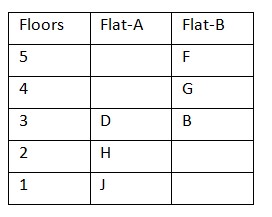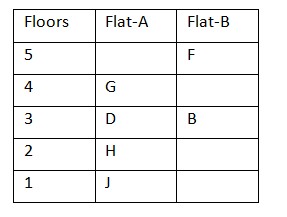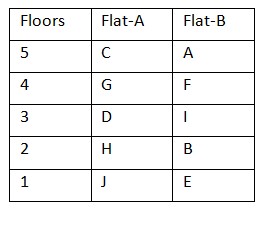Start learning 50% faster. Sign in now
There are two floors between the floors of J and G (both of them may or may not live in the same type of flat). J lives south west of B. J lives on first floor. F lives 2 floors above B (both live in the same type of flat). D lives immediately above H, who doesn’t live below anywhere B’s floor. So, G must live above J’s floor either in flat A or B. Both F and B live in flat B. Case 1: When G lives in the flat B.  Case 2(a): When both G and J live in the same flat and J lives on 1st floor. H doesn’t live below B’s floor, so this case is not possible.
Case 2(a): When both G and J live in the same flat and J lives on 1st floor. H doesn’t live below B’s floor, so this case is not possible.  A lives above D’s floor but not in flat A. E doesn’t live in a prime numbered floor. C doesn’t live immediately above B. So, A lives in on 5th floor in flat B. Case 2(b): When both G and J live in the same flat and J live on 1st floor. The final arrangement is as follows:
A lives above D’s floor but not in flat A. E doesn’t live in a prime numbered floor. C doesn’t live immediately above B. So, A lives in on 5th floor in flat B. Case 2(b): When both G and J live in the same flat and J live on 1st floor. The final arrangement is as follows: 
Consider the following statements about (Braided River Aid: Hydro-Morphological Analyzer) (BRAHMA-2D):
1. Researchers at the IIT Delh...
The first Janjatiya Khel Mahotsav in India was organised at ______.
Recently seen in the news, Ogasawara Islands is situated in which Ocean?
Celebrated fashion designer Rahul Mishra was honored with the insignia of 'Chevalier de l'Ordre des Arts et des Lettres.' This distinction is conferred ...
According to the ‘EnviStats India-2024’ report, which Tiger Reserve ranks first in leopard population?
Claudia Sheinbaum was elected as the first female President of which country in June 2024?
The first International Solar Festival is set to be organized in which city?
In which location were the 1st Foreign Office Consultations between India and Mauritania held?
In which two districts was the ‘EShakti’ pilot project for digitisation of SHGs launched by the National Bank for Agricultural and Rural Development...
Which Indian Naval Ships visited Manila, Philippines as part of their South China Sea operational deployment?